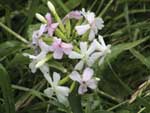Bouncingbet
Saponaria officinalis L.
Keys to Identification
- Flowers are clustered at the ends of branches
- Bouncingbet leaves originate from slightly swollen nodes
This information courtesy of the Colorado Natural Areas Program
Family
Caryophyllaceae (Pink)
Other Names
Soapwort, Lady by the Garden Gate
USDA Code
SAOF4
Legal Status
Colorado Noxious Weed List B
Identification
Lifecycle
Growth form
Perennial forb.
Flower
The flowers are crowded at the ends of branches, and have five petals that are generally pink and slightly notched at the apex. July-Sept.
Seeds/Fruit
Fruits are many-seeded capsules. Seeds are dull-black and roundish or kidney-shaped.
Leaves
Leaves are opposite, smooth, narrow, 2-4 in long and have three distinct veins from the base.
Stems
Mature plants are up to 3 ft tall with stout, erect, smooth, branching stems.
Roots
Rhizomatous root system.
Seedling
No information available.
Similar Species
Exotics
None known.
Natives
Cerastium spp. (mouse-ear) have separate (usually white) petals instead of united petals. Many other members of the pink family appear similar.
Impacts
Agricultural
Can be poisonous to livestock although it is generally considered unpalatable.
Ecological
Spreads rapidly, replacing more valuable species (e.g. perennial grasses).
Habitat and Distribution
General requirements
Often found in large dense patches on hillsides, along river courses, roadsides, meadows, and waste areas. It prefers moist, well-drained soil, and full sun to partial shade and is currently found primarily in municipal areas and nearby wildlands.
Distribution
Scattered throughout the United States. Bouncingbet is increasingly common in Colorado, particularly in residential areas and local open spaces where it has escaped cultivation as an ornamental species.
Historical
Originally introduced from Europe as a garden ornamental and for its saponins, which are the source of it soap-producing qualities (Lokker and Cavers 1995).
Biology/Ecology
Life cycle
Flowering begins in July and continues until September.
Mode of reproduction
Reproduces by seed and spreads clonally by rhizomes.
Seed production
No information available.
Seed bank
No information available.
Dispersal
No information available.
References
Lokker, C. and P.B. Cavers. The effects of physical damage on seed production in flowering plants of Saponaria officinalis. Canadian Journal of Botany 73:235-243.
Whitson, T.D.(ed.), L.C. Burrill, S.A. Dewey, D.W. Cudney, B.E. Nelson, R.D. Lee, R. Parker. 1996. Bouncingbet. Weeds of the West. Western Society of Weed Science, in cooperation with the Western United States Land Grant Universities Cooperative Extension Services, Newark, CA.


